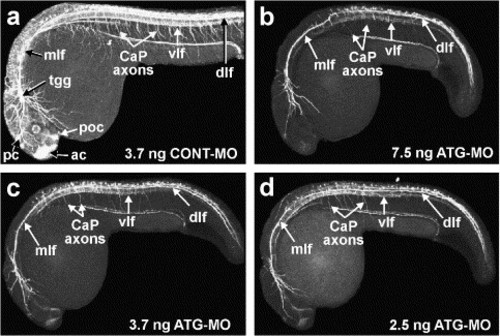Fig. 4
|
Severe reduction in number and density of axon tracts in Neogenin morphants. Whole-mount immunohistochemistry using an anti-α-acetylated tubulin monoclonal antibody was used to visualize the major axon tracts in 24 hpf embryos. (a) In control embryos (3.7 ng CONT-MO), all major axon tracts were present including the dorsal longitudinal fasciculus (dlf), the ventral longitudinal fasciculus (vlf) of the developing neural tube, the medial lateral fasciculus (mlf) coursing from the hindbrain, as well as the anterior (ac), posterior (pc), and post-optic commissures (poc). Axons emanating from the trigeminal ganglia (tgg) and the caudal primary (CaP) motor neurons, which project from the ventral neural tube to the ventral myotome, were readily observed. (b-d) In morphant embryos of varying phenotypic severities (b-d; 7.5, 3.7, and 2.5 ng ATG-MO, respectively), a severe reduction in the number and density of axon tracts along the entire rostrocaudal axis of the embryo was observed. The intense staining in the forebrain, the midbrain, and hindbrain seen in the control brain was almost completely lost. In addition, the mlf, dlf, and vlf in the neural tube comprised significantly fewer fibers. Axons from CaP neurons were also largely absent. (a-d) Lateral views with rostral to the left and dorsal to the top. |
| Fish: | |
|---|---|
| Knockdown Reagent: | |
| Observed In: | |
| Stage: | Prim-5 |
Reprinted from Developmental Biology, 269(1), Mawdsley, D.J., Cooper, H.M., Hogan, B.M., Cody, S.H., Lieschke, G.J., and Heath, J.K., The Netrin receptor Neogenin is required for neural tube formation and somitogenesis in zebrafish, 302-315, Copyright (2004) with permission from Elsevier. Full text @ Dev. Biol.

